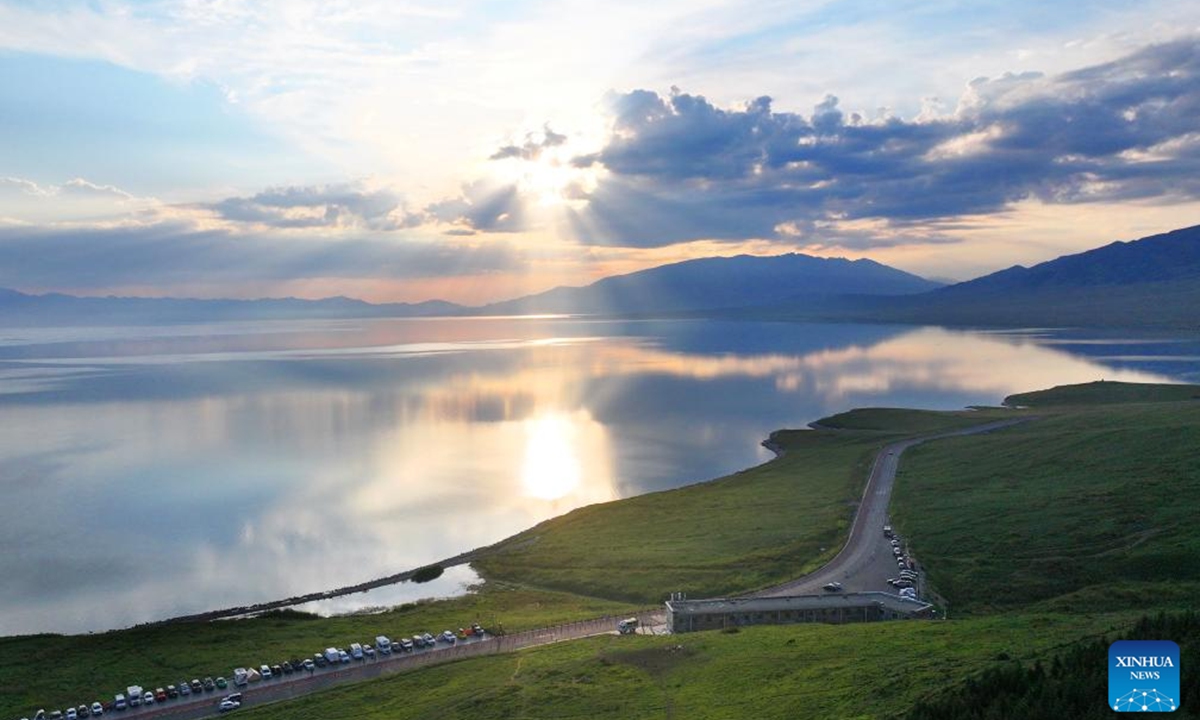
An aerial drone photo taken on July 17, 2025 shows the scenery of Sayram Lake in Bortala Mongolian Autonomous Prefecture, northwest China's Xinjiang Uygur Autonomous Region. Nestled in the Tianshan Mountains, Sayram Lake, Xinjiang's highest and largest alpine lake, has entered its peak tourist season in midsummer. Photo: Xinhua
It's called "Atlantic's last teardrop." But to me, Sayram Lake, in Northwest China's Xinjiang Uygur Autonomous Region, is a drop of blessed water, cupped gently between snow-capped mountains and endless grasslands, and with the people who live alongside it.
I found myself standing at the edge of Sayram Lake in Ili Kazak autonomous prefecture, Xinjiang, marveling at water so clear that even the smallest stones on its bed are visible.
This lake, perched at an altitude of 2,071 meters, stretches across 453 square kilometers - a sapphire of the highlands.
The name "Sayram" is a transliteration from Kazakh language, meaning "wish" or "blessing." Local legend says it was a blessing for safe passage along the ancient Silk Road.
Sayram Lake sits roughly 7,000 kilometers from the eastern shore of the Atlantic Ocean. The atmospheric westerlies born over the Atlantic - like an invisible river - set out from the ocean's gentle embrace, sweep across Europe's forests and coasts, rise and fall over the Caucasus and the Caspian Sea, caress the Kazakh grasslands, then finally ascend the Tianshan Mountains, where they exhaust their last traces of moisture.
Sayram Lake is like an open geology textbook, and, perhaps most evocatively, a living documentary of the long intertwining between East and West. The lake belongs to nature and geography, but even more to all who have wandered and settled by its shores.
From a natural perspective, the Atlantic's influence still lingers; distant humid air still drifts in and cycles through.
Yet on land, dramatic transformations have long since arrived - railways, pipelines, highways, fiber-optic cables, power lines. The winds still come and go with the seasons, but now trains pass, operating on precise timetable.
A bridge leaps across the valley at Guozigou, tunnels punch through mountains; the Northern Xinjiang Railway and highways link Ili with Urumqi (the regional capital), tying China's northwest region to gateways across Central Asia. This connectivity, along with cooperative development projects from other regions, has rapidly improved the lives of ordinary people throughout Ili in recent years.
The wind at Sayram Lake now carries more than the scent of distant lands. It shapes a new kind of aura here - one that determines how resources are gathered and dispersed, how industries are organized, how the environment is protected and how new routes of commerce emerge.
Walking these lakeside paths, I realized that this progress should be visible to anyone, even from afar, through news coverage. So why do some in the US and the West persist in constructing the illusion of "genocide" - Is this not some final grasp for the Atlantic's waning power?
"Forces aiming to isolate China will continue to use the accusation of 'genocide' as their primary weapon."
"However, a thorough analysis of the situation in Xinjiang could convince many people in both developing and industrialized countries that the 'genocide' in Xinjiang is nothing more than a political strategy."
This was written by Simon Zeise, business editor at Berliner Zeitung, in his article published on August 24, 2025.
Xinjiang's development is not meant to be a stage only for outside observers. Eventually, progress here will expose the hollow nature of these manufactured strategic narratives.
The teardrop of the Atlantic, carried by winds and stopped by mountains, finally finds serenity in the timeline of history. Nature assigned it a home; history gave it meaning; the people granted it peace and prosperity.
If you imagine Sayram Lake as a great mirror, it holds three distinct reflections.
The first, and shallowest, are the colors of wind and water - the very mark of nature inscribed in that fabled teardrop.
Deeper still are echoes of roads and borders, traces of camps and post stations by the shore, the transformation from camel bells to the blast of locomotive whistles.
At the deepest level, the lake reflects a tapestry woven from natural climate and human history - an enduring dialogue etched into the landscape.
The author is a senior editor with the People's Daily and currently a senior fellow with the Chongyang Institute for Financial Studies at the Renmin University of China. dinggang@globaltimes.com.cn. Follow him on X @dinggangchina
























































































 京公网安备 11010802037854号
京公网安备 11010802037854号





